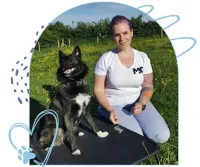
BLOG
New From The Blog

Is My Dog Just A D***
Is My Dog Just A D***
Catchy title right?
It's a really good question though, and one many dog owners ask me. "Is my dog really doing these things just to be difficult?"
Let's look at a few examples -
Adolescence
When dogs become adolescents, they stop doing the cute puppy things in favour of the more challenging antics teenagers get up to, and it isn't because they are being difficult. Dogs become teenagers in every sense of the word, and for some, it really hits them HARD!
There have been recent studies that concluded that during adolescence the dog has a reduced attachment (relationship) with their owner, but more of an attachment with others. Doesn't that sound like most teenage kids?
This is because not only are their brains growing rapidly, but they're flooded with hormones too. The obedient adorable puppy has changed into a disobedient pain in the bum.
This is a completely normal developmental stage and the reason why I created the Awesome Adolescents classes. It's a real struggle and one of the biggest reasons why there are so many adolescent dogs in shelters.
No - your dog isn't being intentionally difficult - they really can't help it!
Your role as a dog owner is to guide them though this because they will come out the other side a different dog. This challenging time won't last forever.
Separation Anxiety
This one is a big one. Separation anxiety can range from the occasional bark and not eating treats until you come home, to a full fear response that results in the poor dog being a dribbling, quivering mess (if this is your dog I urge you to see the help of a trained professional - I can help!). This is absolutely not your dog being difficult.
Again, this is one of the big reasons why most dogs get re-homed, and it can be fixed! It may take some time, but this can absolutely be improved.
Dogs are social creatures and naturally prefer company.
There are some dogs that take everything in their stride and a few hours of alone time is no big deal, it's an opportunity to catch up on some sleep.
Then we have the dogs that may bark for a while but will eventually settle.
Then we have the dogs that scrabble at the doors, vocalise for hours and destroy things like chairs, sofa cushions (even sofas) you name it. You come home to a mess, and quite often toileting in the house when they are fully house trained.
This is NOT your dog being difficult. This is a dog that is frightened to be left alone. Its fear!
Your dog is desperate to find comfort, and does the only thing it knows in that situation that helps just a little.
If you are struggling with some separation anxiety I would advise to grow some distance with your dog. For most owners that struggle with SA their dogs follow them from room to room and are quite literally little velcro dogs. If this is you, try filling a food toy or have a really tasty long lasting chew and give it to them and go for a 15 minute shower but leave them downstairs. This is what we call 'presence doesn't mean access'. They can be in your presence but they cant get to you. This works well if you have baby gates or a barrier of some kind.
This is Tiki practicing presence doesn't mean access.

Lack of boundaries
Dogs need clear and defined rules as to what behaviour is and isn't acceptable in different environments.
Most dog owners are kind people with good intentions. This does not mean that the dog gets a free pass to do whatever he wants, whenever he wants.
Left to their own devices, dogs will explore their new environment by peeing, pooping, and chewing their way through your home. A new dog – at any age – has not earned the privileges of roaming in all areas of the house unrestricted without supervision.We as owners need to make sure that they can be trusted to make appropriate decisions and behave in an appropriate manner in new environments.
Dogs are scavengers and opportunists by nature, but that does not excuse rude habits. Who wants the dog to snag a sandwich off the table or use her belongings or trouser legs as chew toys? Who wants to be the invisible human at the other end of the lead? Without boundaries, the door is wide open to these – among many other inapropriate behaviours.
The use of management techniques (access to space and toileting/chewing preferences) and a rudimentary education in canine learning will serve you well. Teaching your dog to respond reliably to a handful of basic obedience cues will develop a bond of trust and respect between you. This is a simple, but proven formula for human/canine harmony.
Before welcoming a dog into a household we advise to have a really good and clear idea of boundaries for the dog. Such as:
Is the dog allowed upstairs?
Is the dog allowed on the furniture?
Where does the dog sleep?
Where does the dog eat?
Where will the dog be durung human mealtimes?
It really helps to have the whole family on board as so to not confuse the dog because clear boundaries make for a harmonious household.

Ready To Jump Into The Pawtal?
Join our online community of like-minded dog owners that want to change their dog behaviour for the better.
Struggling with dog reactivity? We got you covered!
Is pulling on lead a drag? We have a solution for that!
Your dog doesnt have an 'off' switch? We can create one!
Whatever your dog training struggle, we have a solution for you!
© Copyright 2023 Muttley Crew Dog Training & Behaviour Ltd - Privacy Policy - Terms & Conditions
